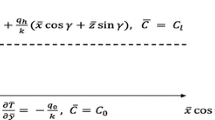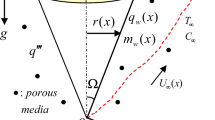Abstract
A linear stability analysis for the onset of internal convection in a composite air-porous layer with the heat source strength depending on the solid volume fraction is carried out through the shooting method. The method is based on the algorithm for constructing a fundamental system of partial solution vectors. We compare the onset values produced by the following three approaches: (1) Darcy approach with the interfacial condition of vanishing tangential velocity (D), (2) Darcy modeling with the Beavers–Joseph condition (\({D_\mathrm{BJ}}\)), and (3) Darcy–Brinkman formulation (DB). The relative difference between the values produced by the \({D_\mathrm{BJ}}\) and DB approaches versus the results obtained by the simplest D model is presented at various solid volume fractions. This difference is the smallest one in the limiting case, when the solid volume fraction tends to unity and the local convection dominates. On the other hand, it can also significantly decrease at some intermediate value of the solid volume fraction that corresponds to an abrupt jump-like transition from local to large-scale convective flows. It has been found that the solid volume fraction and relative depth of the air sublayer speed up the internal convection onset. The onset internal Darcy–Rayleigh number for large-scale convection cannot be reduced by more than ten times, whereas its value for local convection may vary over a wide range covering several orders of the initial magnitude obtained in the absence of air sublayer.














Similar content being viewed by others
Abbreviations
- b :
-
Ratio of volumetric heat capacities
- C :
-
Specific heat capacity
- d :
-
Depth ratio
- \({{\mathrm{Da}}}\) :
-
Darcy number
- g :
-
Acceleration of gravity
- \({h_\mathrm{a}}\) :
-
Depth of air sublayer
- \({h_\mathrm{p}}\) :
-
Depth of porous sublayer
- K :
-
Permeability
- k :
-
Wave number
- m :
-
Porosity, \(\left( {1 - \phi } \right) \)
- P :
-
Pressure excluding the hydrostatic additive
- \({\Pr _\mathrm{p}}\) :
-
Prandtl number in the porous sublayer
- \({Q_\mathrm{s}}\) :
-
Volumetric heat source strength in the solid phase
- \({R_I}\) :
-
Internal Darcy–Rayleigh number normalized by the solid volume fraction
- \(R{a_I}\) :
-
Internal Darcy–Rayleigh number, \(\phi {R_I}\)
- T :
-
Temperature
- t :
-
Time
- \({\mathbf{{V}}_\mathrm{a}}\) :
-
Velocity in the air sublayer
- \({\mathbf{{V}}_\mathrm{p}}\) :
-
Seepage velocity in the porous sublayer
- x :
-
Coordinate of longitudinal axis
- z :
-
Coordinate of transversal axis
- \({\alpha _\mathrm{BJ}}\) :
-
Beavers–Joseph coefficient
- \(\beta \) :
-
Thermal expansion coefficient
- \({{\gamma }}\) :
-
Unit vector of the z-axis
- \({\delta _{Ra}}\) :
-
Relative deviation of the Darcy–Rayleigh number from the reference value
- \(\kappa \) :
-
Thermal conductivity ratio
- \({\kappa _\mathrm{a}}\) :
-
Thermal conductivity of air sublayer
- \({\kappa _\mathrm{p}}\) :
-
Thermal conductivity of porous sublayer
- \(\lambda \) :
-
Growth rate of the disturbance
- \(\nu \) :
-
Air kinematic viscosity
- \({\rho _0}\) :
-
Air density at \(T = {T_0}\)
- \({\chi _\mathrm{eff}}\) :
-
Effective thermal diffusivity of porous sublayer, \({{{\kappa _p}} / {{{\left( {{\rho _0}C} \right) }_a}}}\)
- \({\chi _\mathrm{a}}\) :
-
Thermal diffusivity of air sublayer, \({{{\kappa _a}} / {{{\left( {{\rho _0}C} \right) }_a}}}\)
- \(\phi \) :
-
Solid volume fraction
- \(\nabla \) :
-
Nabla operator
- \(\Theta \) :
-
Dimensionless temperature deviation from the reference value \({T_0}\)
- a :
-
Air sublayer
- l :
-
The lower boundary of porous sublayer
- p :
-
Porous sublayer
- s :
-
Solid
- u :
-
The upper boundary of air sublayer
References
Chen, F., Chen, C.F.: Onset of finger convection in a horizontal porous layer underlying a fluid layer. J. Heat Trans. 110, 403–409 (1988)
Worster, M.G.: Instabilities of the liquid and mushy regions during solidification of alloys. J. Fluid Mech. 237, 649–669 (1992)
Straughan, B.: Effect of property variation and modelling on convection in a fluid overlying a porous layer. Int. J. Numer. Anal. Methods Geomech. 26, 75–97 (2002)
Kolchanova, E., Lyubimov, D., Lyubimova, T.: The onset and nonlinear regimes of convection in a two-layer system of fluid and porous medium saturated by the fluid. Transp. Porous Med. 97, 25–42 (2013)
Mccurdy, M., Moore, N., Wang, X.: Convection in a coupled free flow-porous media system. SIAM J. Appl. Math. 79, 2313–2339 (2019)
Lyubimova, T.P., Muratov, I.D.: Interaction of the longwave and finite-wavelength instability modes of convection in a horizontal fluid layer confined between two fluid-saturated porous layers. Fluids 2, 39 (2017)
Nield, D.A., Bejan, A.: Convection in Porous Media. Springer, Switzerland (2017)
Beavers, G.S., Joseph, D.D.: Boundary conditions at a naturally permeable wall. J. Fluid Mech. 30, 197–207 (1967)
Le Bars, M., Worster, M.G.: Interfacial conditions between a pure fluid and a porous medium: implications for binary alloy solidification. J. Fluid Mech. 550, 149–173 (2006)
Jones, I.P.: Low Reynolds number flow past a porous spherical shell. Math. Proc. Cambridge Philos. Soc. 73, 231–238 (1973)
Saffman, P.: On the boundary condition at the surface of a porous media. Stud. Appl. Math. 50, 292–315 (1971)
Nield, D.A.: The Beavers–Joseph boundary condition and related matters: a historical and critical note. Transp. Porous Med. 78, 537–540 (2009)
Hsu, C.T., Cheng, P.: Thermal dispersion in a porous medium. Int. J. Heat Mass Transf. 33, 1587–1597 (1990)
Hill, A., Straughan, B.: Global stability for thermal convection in a fluid overlying a highly porous material. Proc. R. Soc. A 465, 207–217 (2009)
Hill, A., Carr, M.: Nonlinear stability of the one-domain approach to modelling convection in superposed fluid and porous layers. Proc. R. Soc. A 466, 2695–2705 (2010)
Hirata, S.C., Goyeau, B., Gobin, D., Chandesris, M., Jamet, D.: Stability of natural convection in superposed fluid and porous layers: equivalence of the one- and two-domain approaches. Int. J. Heat Mass Transf. 52, 533–536 (2009)
Kulacki, F., Ramchandani, R.: Hydrodynamic instability in a porous layer saturated with a heat generating fluid. Wärme und Stoffübertragung-Thermo Fluid Dyn. 8, 179–185 (1975)
Kuznetsov, A.V., Nield, D.A.: The effect of strong heterogeneity on the onset of convection induced by internal heating in a porous medium: a layered model. Transp. Porous Med. 99, 85–100 (2013)
Carr, M.: Penetrative convection in a superposed porous-medium-fluid layer via internal heating. J. Fluid Mech. 509, 305–329 (2004)
Nouri-Borujerdi, A., Noghrehabadi, A.R., Rees, D.A.S.: Influence of Darcy number on the onset of convection in a porous layer with a uniform heat source. Int. J. Thermal Sci. 47, 1020–1025 (2008)
Shalbaf, S., Noghrehabadi, A., Assari, M.R., Dezfuli, A.D.: Linear stability of natural convection in a multilayer system of fluid and porous layers with internal heat sources. Acta Mech. 224, 1103–1114 (2013)
Lisboa, K.M., Su, J., Cotta, R.M.: Single domain integral transform analysis of natural convection in cavities partially filled with heat generating porous medium. Numer. Heat Transf. Part A (2018). https://doi.org/10.1080/10407782.2018.1511141
Carman, P.C.: Fluid flow through granular beds. Trans. Inst. Chem. Eng. 15, S32–S48 (1937)
Altukhov, I.V., Ochirov, V.D.: Thermalphysic characteristics as the basis of calculation of the heating time constant of the sacchariferous root crops in the thermal processing processes. Bull. KrasGAU. 4, 134–139 (2010). ((in Russian))
Horton, C.W., Rogers, F.T.: Convection currents in a porous medium. J. Appl. Phys. 16, 367–370 (1945)
Lobov, N.I., Lyubimov, D.V., Lyubimova, T.P.: Numerical Methods of Solving the Problems in the Theory of Hydrodynamic Stability. PSU Publishers, Perm (2004). ((in Russian))
Voevodin, V.V.: Computational Foundations of Linear Algebra. Nauka, Moscow (1977).. ((in Russian))
Acknowledgements
The work was supported by the Russian Science Foundation (Grant No. 21-71-10045), https://rscf.ru/en/project/21-71-10045/. The authors also would like to thank the very competent Reviewers for their valuable comments and suggestions.
Author information
Authors and Affiliations
Corresponding author
Additional information
Publisher's Note
Springer Nature remains neutral with regard to jurisdictional claims in published maps and institutional affiliations.
Rights and permissions
About this article
Cite this article
Kolchanova, E., Kolchanov, N. Onset of internal convection in superposed air-porous layer with heat source depending on solid volume fraction: influence of different modeling. Acta Mech 233, 1769–1788 (2022). https://doi.org/10.1007/s00707-022-03204-8
Received:
Revised:
Accepted:
Published:
Issue Date:
DOI: https://doi.org/10.1007/s00707-022-03204-8




